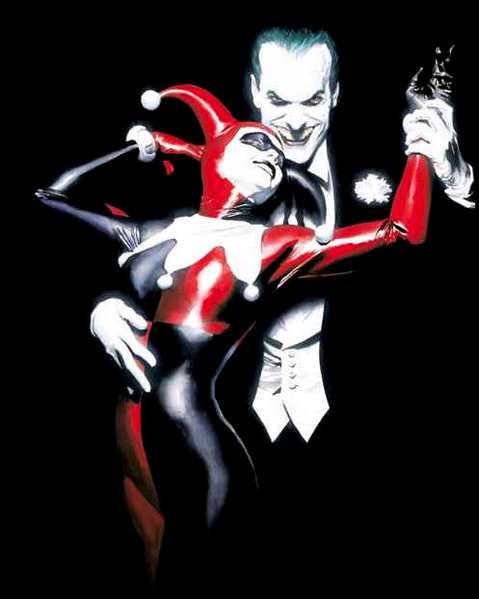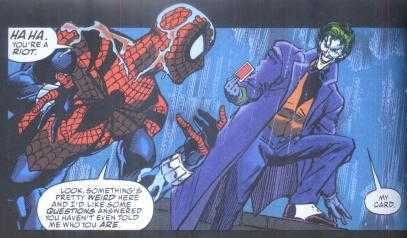Post by amxfiles on Oct 19, 2005 20:48:41 GMT -5

Real name: Unknown (possibly Jack Napier according to the 1989 movie.)
Status: Active
Affiliations: None
Previous affiliations: Injustice Gang, Harley Quinn, assorted Batman rogues
Notable aliases: Red Hood I, Clown Prince of Crime, Harlequin of Hate, Jack Napier, Joe Kerr, Mr. J
Notable relatives: Jeannie (Wife - deceased), unborn child (deceased), Melvin Reipan (deceased)
Notable powers: Fiendish intelligence, particularly in the field of chemistry.
Utterly psychopathic.
Character analysis
The Joker is also referred to as the Clown Prince of Crime and the Harlequin of Hate. Throughout the evolution of the Batman universe, interpretations and incarnations of the Joker have taken two forms. The original and currently dominant image is of a sadistic, fiendishly intelligent psychopath with a warped sense of humor, deriving pleasure from inflicting grotesque, morbid death and terror upon innocent people. In this interpretation, he is a textbook example of antisocial personality disorder; in a sense he is Charles Manson cursed with a clown's grinning face and a grotesque sense of showmanship. The other interpretation of the Joker, popular in the late 1940s through 1960s comic books as well as the 1960s television series, portrays the Joker as an eccentric but harmless prankster and thief. The 1990s cartoon Batman: The Animated Series is notable for blending these two aspects, but most interpretations tend to embrace one characterization or the other.
Part of the Joker's prominence among Batman's enemies likely derives from the fact that he, more than any other villain, represents the antithesis of Batman's personality and methods. Batman is almost always depicted, even in the campy 1960s television show, as a serious, stoic man who pursues his campaign against crime with utter earnestness and a disciplined, focused mind. In the darker portrayals of the comics and more recent films and television, the Dark Knight is further depicted as a brooding and humorless avenger who pursues justice as an enigmatic shadow striking from the dead of night. The Joker, by contrast, is literally a killer clown, driven by a disordered and chaotic mind to pursue destruction and chaos with as much panache as possible. His appearance and actions suggest the bright and garish pomp and circumstance of the circus. Nightwing has stated that he believes the Joker and Batman exist because of each other, that Batman represents order and the Joker represents the chaos that challenges it. Like Superman and Lex Luthor, it has been suggested that Batman and the Joker need each other. The Joker's obsession with Batman is somewhat unique to other super heroes and villians. In the movie Batman Beyond: Return of the Joker, the new Batman said to the Joker that the only real reason he kept coming back was because he never got a laugh out of the original Batman. The Joker has also said that without Batman, his life is nothing. In an episode of Batman: The Animated Series, when it was thought a young upstart in the crime syndicate killed Batman, Joker held his own funeral for Batman at the very place he had his "accident" and even nailed the man who supposedly killed him in the coffin and dropped it in a vat of acid. In "Going Sane", a story featured in Batman: Legends of the Dark Knight, The Joker thinks he finally succeeded in his ultimate goal of killing Batman. The act leads him to revert to sanity, which results in him getting plastic surgery in order to look like a normal human being. Donning the name Joseph Kerr and engaging in a small romance with his neighbor were among many things the Joker did to try and lead an honest life. Normalcy did not last for the Joker though, when he discovered the Batman to be alive it drove him back to insanity, causing him mutilate himself and restore the trademark white skin, green hair and crimson lips once more. The Joker then resumed his quest to cripple Batman.
In one of the comics in the 1970's, the Joker, by a random and unexpected occurence, knocked out Batman and considered unmasking and killing him there but decided not too, his logic being that his victory over Batman had to be public and had to be something astounding; not some accident the Joker didn't mean to do. In another issue, the Joker threatened crime boss Rupert Thorne to stop trying to find out Batman's identity. Thorne had Hugo Strange find out and when Strange would not tell him who Batman was, Thorne had him killed. The Joker was also bidding for Batman's identity, alongside the Penguin, and said to Thorne he was lucky Strange took whatever secrets he held with him to the grave. Thorne replied "you're actually defending him?" and Joker explained that he's destined to defeat Batman and his death has to be something worthy of the Joker and no one else is to defeat Batman except for him.
What also makes the Joker Batman's greatest foe is not only his insanity, but also his unpredictablity. While certain villians have one method to commit a crime or to fight, such as Mr. Freeze with his freeze gun or Poison Ivy with her plants, Joker has many different methods. He has a variety of weapons at his disposal, and you never know what kind of weapon it is. For example, Joker always has a flower on his jacket and it almost always has a different use. It either sprays acid or his trademark laughing gas, or it could on some occasions just be an ordinary flower. Sometimes he commits crimes just for the fun of it, or it could be a small part of a much grander scheme. Batman has been noted to say that you always have to expect the unexpected when it comes to the Joker and that his plans make sense to him alone. The Joker's unpredictability makes him one of the most dangerous villains of all time.
Character history
The definitive origin and actual name for the character was never established in the comics (although some people now assume his real name is Jack Napier as in the 1989 Batman movie). In a 1951 story, an origin was told in which he was originally a criminal who called himself the "Red Hood." In an encounter with Batman, he jumped into a pool of chemicals to escape pursuit, and this permanently dyed his skin white, his lips red, and his hair green, giving him the appearance of a ghastly clown. (In the light of later developments, it is worth noting that even in this story, the only source of information about who the Joker was before his fateful run-in with Batman is the Joker's own recollection.)
The first origin to have been given to the Joker was in a 1956 comic where the Red Hood returned to rob the univeristy of Gotham. In the issue, Batman states that the Red Hood has been the only villain to ever escape him. At the end of he issue, Batman and Robin discover that the Joker was the Red Hood and donned the hood again in light of the case being reopened. Joker tells Batman that after trying to break into the Ace Monarch Card Company, he escaped through the chemical plant next to the factory and swam through a chemical pipe out into the lake. Only when he got home and took the mask off did he discover he had been transformed and designed himself after the playing card since he looked like a clown. He said he had kept this information from Batman for years so he would keep guessing. This origin, being the first origin offered for the Joker, states that he was in crime long before the accident occurred. However, again due to later developments, this is coming from the Joker's own memory and is largely unreliable.
This origin was greatly expanded upon in the 1988 graphic novel, Batman: The Killing Joke written by Alan Moore. In that story, the Joker was an unnamed engineer who quit his job at a chemical company to become a stand-up comedian, only to fail miserably. Desperate to support his pregnant wife, he agreed to guide two criminals into the plant for a robbery. During the planning, the police came and informed him that his wife had just died in a household accident. Grief-stricken, the engineer tried to withdraw from the plan, but the criminals strong-armed him into keeping his commitment to them.
At the plant, the criminals made him don a special mask to become the infamous Red Hood. Unknown to the engineer, this was simply a way to implicate any accomplice as the mastermind of a crime to divert attention from themselves. Once inside, they almost immediately blundered into security personnel and a violent shootout and chase ensued. The criminals were gunned down and the engineer found himself confronted by Batman, who was investigating the disturbance.
In panicked desperation, the engineer escaped by diving into a toxic waste vat and swam through a pipe leading to the outside. Once there, he discovered, to his horror, that the chemicals permanently stained his skin chalk white, his lips ruby red and his hair bright green. This turn of events, compounded by the man's misfortunes on that one day, caused him to go completely insane and resulted in the birth of the Joker.
In a 2004 comic book (Batman: Gotham Knights #54), it was heavily implied that much of the above origin was in fact true (and that the Joker's first name was Jack), with details of it being backed up by a witness to the death of the Joker's wife. In this version, however, his wife was kidnapped and murdered by those same gangsters, in order to force his cooperation in the Red Hood robbery. The witness was none other than Edward Nigma, who would eventually become the Riddler.
In the short story "On a Beautiful Summer's Day, He Was" by Robert McCammon, featured in the anthology The Further Adventures of the Joker, the Joker is suggested to have been born a monster, not made one by bad luck. The story concerns him as a young boy who derives pleasure from killing small animals (considered the hallmark sign of a budding sociopath) and collecting their bones. The story notes that his father is also insane and, in a chilling scene, beats his mother while the boy listens through the wall, grinning. The end of the story has him graduating to murder, killing a neighborhood boy who discovers his makeshift graveyard. The story identifies the Joker's last name as Napier.
In "Best of All," another story in the anthology, the Joker murdered his abusive father as a child. His mother was revealed to be Batman's old friend and confidante Leslie Thompkins, which he revealed to Batman to torment him.
Any recountings of the Joker's origin are largely unreliable, however, as they are taken directly from his own memories, and as he himself puts it in The Killing Joke, "I'm not exactly sure what happened. Sometimes I remember it one way, sometimes another... If I'm going to have a past, I prefer it to be multiple choice!"
Powers and abilities
The Joker's powers are his countless "comedic" weapons (such as razor sharp playing cards, acid-spewing flowers, and lethally electric joy buzzers) and Joker venom, a deadly poison that infects his victims with a ghoulish rictus grin as they die while laughing uncontrollably (although some versions cause immediate death, without the painful laugh spasms beforehand.) This venom comes in many forms, from gas to darts to liquid poison, and has been his primary calling card from 1940 till the present. In the 1989 movie, it was dubbed "Smilex." The Joker is also very skilled in the field of chemistry and is a good hand-to-hand combatant.
Some stories have speculated that the Joker's insanity may be a super power in and of itself. It is often implied that the Joker was transformed both physically and mentally by the accident which bleached his skin, much like a traditional superhero origin. Batman: The Animated Series goes so far as to imply that exposing others to the same process will grant them Joker-like "powers"; specifically, this occurs in the episode "Beware the Creeper", which created a new version of the DC Comics character The Creeper. In Elseworlds: Distant Fires, the Joker is rendered sane by the nuclear war which deprives all super beings of their powers. In Arkham Asylum, a psychiatrist suggests that the Joker's mental condition is an instance of "super-sanity," a unique form of extrasensory perception. It has occaisonally been implied that the Joker's perception extends beyond the limits endured by the merely sane, up to and including awareness of being a comic-book character. In its short run, Amalgam Comics had super beings from Marvel Comics and DC Comics appearing in each other's universes, much confused and unrecognized by the native population. However, upon encountering the Marvel character Spider-Man in Gotham the Joker spoke in familiar terms and even commented on Spider-Man's costume change, an oblique reference to an older cross-over tale which had subsequently been retcon-ed out of existence.
During the "Knightfall" saga, Scarecrow and Joker team up and kidnap the mayor of Gotham. After Batman rescues him, Scarecrow turns on the Joker and uses his fear gas to see what Joker is afraid of. To Scarecrow's suprise, the gas has no affect on Joker and he, in turn, beats Scarecrow with a wooden chair. This suggests that due to his insanity, the Joker literally has no fear.

--------------------------------------------------------------------------------------------------------------------
Okay, so I just watched the 1989 Batman movie, sue me

Since Chase posted our Hero of the Day, and it was DC, might as well keep that trend alive.









 ing Batplane with a long gun.
ing Batplane with a long gun. 




